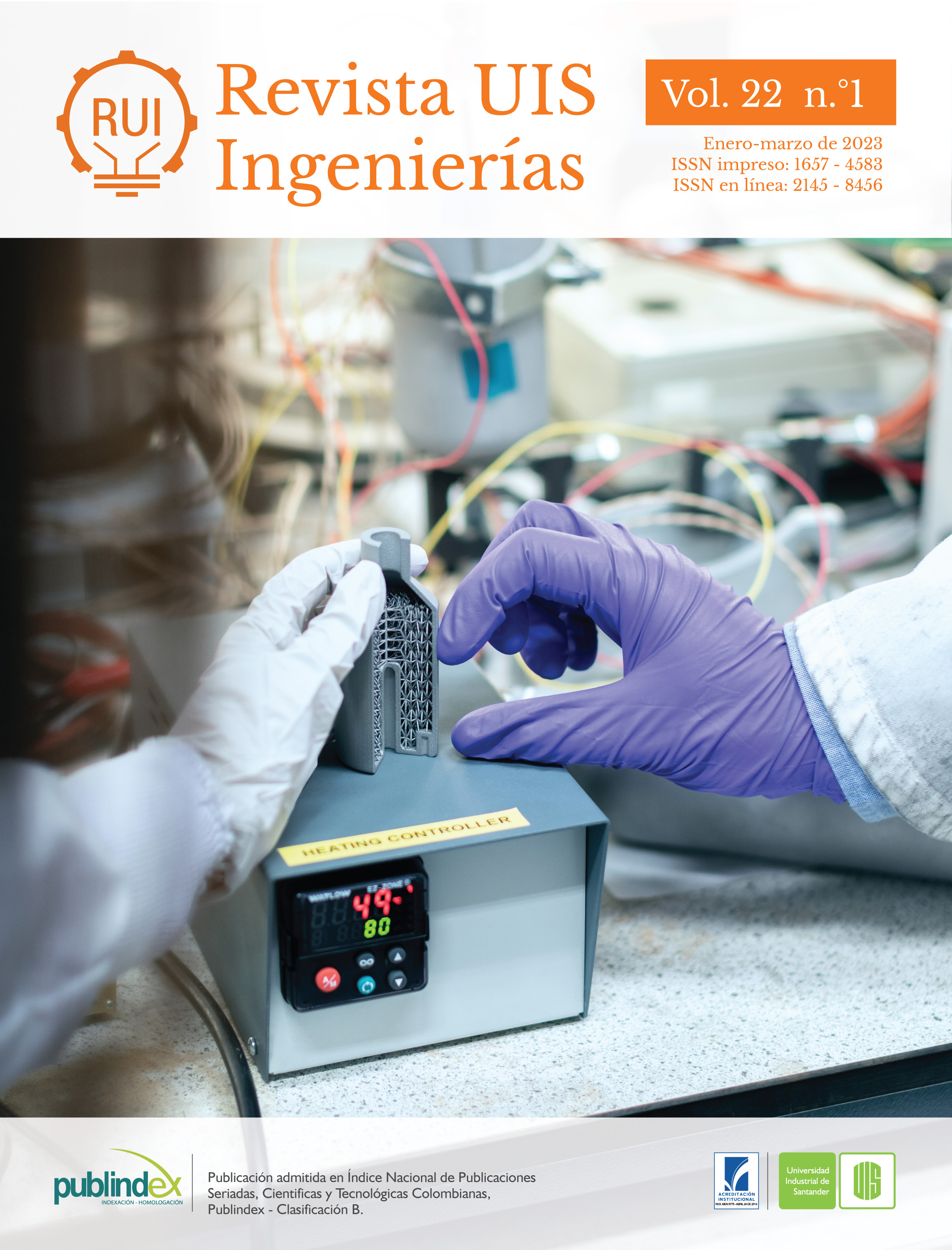Published 2023-01-02
Keywords
- assertiveness,
- database,
- characteristics,
- estimation,
- data cleansing
- vector support machine,
- samples,
- artificial neural networks,
- validation,
- treatment ...More
How to Cite
Copyright (c) 2023 Revista UIS Ingenierías

This work is licensed under a Creative Commons Attribution-NoDerivatives 4.0 International License.
Abstract
Traditional data processing applications are unsuitable for handling large amounts of data. To achieve an efficient manipulation and extraction of characteristics or samples that the information represents, it is necessary to know aspects such as data collection and treatment. In this document, a database corresponding to the behavior of electrical energy consumption in a residential load was refined. The debugging and statistical analysis of the samples were carried out using the principal component analysis. The training of the smallest data set to the original database was made using vector support machine techniques and artificial neural networks. Finally, a proposal is presented for the analysis of samples that are within the operating limits or not using updating dynamic patterns for the unsupervised validation of new samples.
Downloads
References
- E. Hernandez-Leal, N. Duque-Mendez, J. Moreno Cadavid, “Big Data: una exploración de investigaciones, tecnologías y casos de aplicación”, TecnoLógicas, vol. 20, no 39, pp. 17-24, 2017, doi: https://doi.org/10.22430/22565337.685
- R. Alvaro-Hermana, J. Fraile-Ardanuy, J. Merinod, “Algorithm development for night charging electric vehicles optimization in big data applications”, Procedia Computer Science, vol. 109, pp. 793-800, 2017, doi: https://doi.org/10.1016/j.procs.2017.05.329
- X. Zhao, “Research on management informatization construction of electric power enterprise based on big data technology”, Energy Reports, vol. 8, no 7, pp. 535-545, 2022, doi: https://doi.org/10.1016/j.egyr.2022.05.124
- A. Fernández, A. Gómez, F. Lecumberry, A. Pardo, I. Ramírez, “Pattern Recognition in Latin America in the “Big Data” Era”, Pattern Recognition, vol. 48, pp. 1185-1196, 2015, doi: https://doi.org/10.1016/j.patcog.2014.04.012
- C. G. Kiran, V. P. Lekhesh, R.V. Abdu, K. Rajeev, “Traffic Sign Detection and Pattern Recognition using Support Vector Machine”, Seventh International Conference on Advances in Pattern Recognition, Kolkata, 2009, pp. 87-90, doi: https://doi.org/10.1109/ICAPR.2009.58
- O. V. Senko, A. V. Kuznetsova, “Pattern recognition method using ensembles of regularities found by optimal partitioning”, 20th International Conference on Pattern Recognition, Estambúl, 2010, pp. 2957–2960, doi: https://doi.org/10.1109/ICPR.2010.724
- Center for Machine Learning and Intelligent Systems, “Individual household electric power consumption Data Set”, 2012. [Online]. Available: https://archive.ics.uci.edu/ml/datasets/Individual+household+electric+power+consumption
- J. Li, X. Chu, W. He, F. Ma, R. Malekian, Z. Li, “A Generalised Bayesian Inference Method for Maritime Surveillance Using Historical Data”, Symmetry, vol. 11, pp. 188, 2019, doi: https://doi.org/10.3390/sym11020188
- S. Santoso, Standard Handbook for Electrical Engineers, Seventeenth Edition. US: McGraw-Hill Education, 2018.
- P.S.P. Ignacio, I.K. Darcy, “Tracing patterns and shapes in remittance and migration networks via persistent homology”, EPJ Data Science, vol. 8, pp. 1-23, 2019, doi: https://doi.org/10.1140/epjds/s13688-018-0179-z
- E. Guzmán, M. Vázquez, D. del Valle, P. Pérez-Rodríguez, “Artificial Neuronal Networks: A Bayesian Approach Using Parallel Computing”, Revista Colombiana de Estadística, vol. 41, pp. 173-189, 2018, doi: http://dx.doi.org/10.15446/rce.v41n2.55250
- J. Calvo-Zaragoza, J. Oncina, “An efficient approach for Interactive Sequential Pattern Recognition”, Pattern Recognition, vol. 64, pp. 295-304, 2017, doi: http://dx.doi.org/10.1016/j.patcog.2016.11.006
- M. Zhang, Y. Liu, Z. Liu, J. Wang, M. Gong, H. Ge, X. Li, Y. Yang, Z. Zou, “Hyper-acidic fusion minipeptides escort the intrinsic antioxidative ability of the pattern recognition receptor CRP in non-animal organisms”, Scientific Reports, vol. 9, pp. 1-15, 2019, doi: https://doi.org/10.1038/s41598-019-39388-8
- A. S. Iwashita, V. H. C. de Albuquerque, J. P. Papa, “Learning concept drift with ensembles of optimum-path forest-based classifiers”, Future Generation Computer Systems, vol. 95, pp. 198-211, 2019, doi: https://doi.org/10.1016/j.future.2019.01.005
- P. Carravilla, J. Chojnacki, E. Rujas, S. Insausti, E. Largo, D. Waithe, B. Apellaniz, T. Sicard, J. Julien, C. Eggeling, J. Nieva, “Molecular recognition of the native HIV-1 MPER revealed by STED microscopy of single virions”, Nature Communications, vol. 10, 2019, doi: https://doi.org/10.1038/s41467-018-07962-9
- M. Zhang, Y. Liu, Z. Liu, J. Wang, M. Gong, H. Ge, X. Li, Y. Yang, Z. Zou, “Online modeling and identification of plug-in electric vehicles sharing a residential station”, International Journal of Electrical Power & Energy Systems, vol. 108, pp. 162-176, 2019, https://doi.org/10.1016/j.ijepes.2018.12.024

